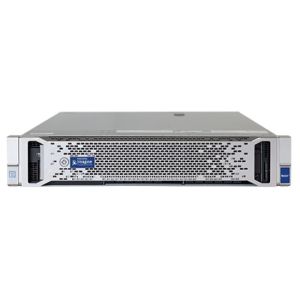Imagine NXFCCDAE FCCBL- OPTICAL- LC TO LC 50/125 CON.5M/1.64FT;...
Imagine NXFCCDAE FCCBL- OPTICAL- LC TO LC 50/125 CON.5M/1.64FT; Optical fiber cable, LC TO LC 50/125 con, 0.5m/1.64 ft, NXS3000/NXS3100 storage array interconnect cable, DAE to DAE connection. May be used to connect NXESB Series switches via 10GigE SFP+ ports
0.5 m Optical fibre cable, LC to LC 50/125, FC or 10GEThe NXESB624 24-port and NXESB648 48-port 10/100/1000BaseT Ethernet switches are specifically tested and qualified for use with the NEXIO video server product line for LAN communications and file transfer.
Focused on enterprise-class networking, the NXESB 600 Series Ethernet switches are widely accepted by broadcasters and IT departments alike in market segments where NEXIO servers are sold. The switches offer proven network performance and reliability, and are available with optional redundant power supply modules. The NXESB 600 Series underlines the Imagine Communications commitment to enterprise-class computing.
Features
- Enterprise-class, stackable Layer 2/3 edge switches with 24 or 48 10/100/1000 Mb/s ports in compact 1RU form factors
- Layer 3 capabilities — including OSPF, RIP, VRRP and PIM — come standard on all models
- Modular design with internal hot-swappable power supplies and fans
- Optional redundant power/cooling module
- Optional four-port 10 Gb/s SFP+ module
Details
Connectivity between NEXIO I/O nodes for inter-node communications and for third-party automation control. This ensures that all I/O nodes have up-to-date metadata information, and supports content management and channel control by remote computers.
When used for file transfer, the switches offer high-performance Gigabit Ethernet connectivity. They are ideally suited to high-bandwidth, high-volume Gigabit Ethernet data movement. They can be used with NEXIO low-resolution browse/edit solutions, FTP, NAS, CIFS, file- and folder-based transfer, and third-party Ethernet-based media device support. They can be used for NEXIO inter-node communication, automation control and file transfer at the same time.
NXESB624 and NXESB648 switches are based on the Brocade FCX Series of switches, providing new levels of performance, scalability and flexibility required by today’s large-scale NEXIO networks. With advanced capabilities, these switches deliver performance and intelligence in a flexible 1RU form factor that reduces the total cost of ownership.
By using two NXESB624 or two NXESB648 switches in a NEXIO server SAN (storage area network) system, a redundant Ethernet topology can be created for NEXIO inter-node communication. The NEXIO real-time system uses low-level control of the Ethernet interfaces for the most effective control and detection of errors requiring failover to an alternate data pathway. This approach protects the system from a port, cable or complete Ethernet switch failure. In the event of a failure, the system sends probe commands to detect whether the alternate pathway is available. Once connectivity is re-established, the system will automatically start using the redundant configuration again.
The optional four-port 10-Gigabit Ethernet module expands the network connectivity options. NXESB 600 Series switches can use the 10 Gb connections to stack up to three switches with 10 Gb devices such as NEXIO Media Host servers or archive storage, or to link one or more Gigabit Ethernet switches to the NXESBTI24 24-port 10-Gigabit Ethernet switch.
Specifications
Specifications and designs are subject to change without notice
| Systems Architecture | |
|---|---|
| Connector Options | 24 or 48 10/100/1000 Mb/s ports: RJ-45 Optional: Four 10 Gb/s SFP+ ports: Direct-Attached Copper (Twinax), SR, LR Out-of-band Ethernet management: RJ-45 (fixed) Console management: DB9 |
| Maximum MAC Addresses | 32,000 |
| Maximum VLANs | 4096 |
| Maximum STP (spanning trees) | 255 |
| Maximum Routes (in hardware) | 16,000 |
| Trunking | Maximum ports per trunk: 8 |
| Maximum Trunk Groups | 60 |
| Maximum Jumbo Frame Size | 9000 bytes |
| IEEE Standards Compliance | 802.1AB LLDP/LLDP-MED 802.1D-2004 MAC Bridging 802.1p Mapping to Priority Queue 802.1s Multiple Spanning Tree 802.1w Rapid Spanning Tree 802.1x Port-based Network Access Control 802.3 10 Base-T 802.3ab 1000 Base-T 802.3ad Link Aggregation (Dynamic and Static) 802.3ae 10 Gigabit Ethernet 802.3af Power over Ethernet 802.3ak CX4 802.3u 100 Base-TX 802.3x Flow Control 802.3z 1000Base-SX/LX 802.3 MAU MIB (RFC 2239) |
| Layer 2 Switching | 802.1s Multiple Spanning Tree 802.1x Authentication Auto MDI/MDIX BPDU Guard, Root Guard Dual-Mode VLANs Dynamic VLAN Assignment Dynamic Voice VLAN Assignment Fast Port Span Flexible Static Multicast MAC Address Configuration GARP VLAN Registration Protocol IGMP Snooping (v1/v2/v3) Link Fault Signaling (LFS) MAC Address Locking MAC-Layer Filtering MAC Learning Disable; Port Security MLD Snooping (v1/v2) Multi-device Authentication Per VLAN Spanning Tree (PVST/PVST+/PVRST) PIM–SM Snooping Policy-controlled MAC-based VLANs Port-based Access Control Lists Port-based, ACL-based, MAC Filter-based, and VLAN-based Mirroring Port Loop Detection Port Speed Downshift and Selective Auto-negotiation Private VLAN Private VLANs and Uplink Switch Protected Link Groups Protocol VLAN (802.1v), Subnet VLAN Remote Fault Notification (RFN) Single-instance Spanning Tree Single-link LACP Trunk Groups Trunk Threshold UniDirectional Link Detection (UDLD) |
| Layer 3 Routing | ECMP Host routes IPv4 Static Routes Layer 3/Layer 4 ACLs RIP v1/v2 announce OSPF v2 PIM-SM, PIM-SSM, PIM-DM RIP v1/v2 Routed Interfaces Route-only Support Routing Between Directly Connected Subnets Virtual Interfaces Virtual Route Redundancy Protocol (VRRP) |
| Metro Features | Metro-Ring Protocol (v1, v2) Virtual Switch Redundancy Protocol (VSRP) VLAN Stacking (Q-in-Q) VRRP, VRRP-E Topology Groups |
| Quality of Service | ACL Mapping and Marking of ToS/DSCP ACL Mapping to Priority Queue ACL Mapping to ToS/DSCP Classifying and Limiting Flows Based on TCP Flags DHCP Relay DiffServ Support Honoring DSCP and 802.1p MAC Address Mapping to Priority Queue QoS Queue Management using Weighted Round Robin (WRR), Strict Priority (SP), and a combination of WRR and SP |
| High Availability | Redundant hot-swappable internal power supplies Hot-swappable fan assembly Layer 3 VRRP protocol redundancy Real-time state synchronization across the stack Hitless failover from master to standby stack controller Protected link groups Hot insertion and removal of stacked units |
| Traffic Management | ACL-based inbound rate limiting and traffic policies Broadcast, multicast, and unknown unicast rate limiting Inbound rate limiting per port Outbound rate limiting per port and per queue |
| Management | |
|---|---|
| Management and Control | Auto Configuration Configuration Logging Digital Optical Monitoring Display Log Messages on Multiple Terminals Embedded Web Management Embedded DHCP Server Foundry Discovery Protocol (FDP) Industry-Standard Command Line Interface (CLI) Key-based activation of optional software features Integration with HP OpenView for Sun Solaris, HP-UX, IBM AIX, and Windows Brocade Network Advisor IronView Network Manager (INM) Version 3.2 or later MIB Support for MRP, Port Security, MAC Authentication, and MAC-based VLANs Out-of-band Ethernet Management RFC 783 TFTP RFC 854 TELNET Client and Server RFC 1157 SNMPv1/v2c RFC 1213 MIB-II RFC 1493 Bridge MIB RFC 1516 Repeater MIB RFC 1573 SNMP MIB II RFC 1643 Ethernet Interface MIB RFC 1643 Ethernet MIB RFC 1724 RIP v1/v2 MIB RFC 1757 RMON MIB RFC 2068 Embedded HTTP RFC 2131 DHCP Server and DHCP Relay RFC 2570 SNMPv3 Intro to Framework RFC 2571 Architecture for Describing SNMP Framework RFC 2572 SNMP Message Processing and Dispatching RFC 2573 SNMPv3 Applications RFC 2574 SNMPv3 User-based Security Model RFC 2575 SNMP View-based Access Control Model SNMP RFC 2818 Embedded HTTPS RFC 3176 sFlow SNTP Simple Network Time Protocol Support for Multiple Syslog Servers |
| Embedded | 802.x Accounting MAC Authentication Bi-level Access Mode (Standard and EXEC Level) EAP pass-through support IEEE 802.1X username export in sFlow Protection against Denial of Service (DoS) attacks |
| Secure Management | Authentication, Authorization, and Accounting (AAA) Advanced Encryption Standard (AES) with SSHv2 RADIUS/TACACS/TACACS+ Secure Copy (SCP) Secure Shell (SSHv2) Username/Password Web authentication |
| Mechanical | |
|---|---|
| Enclosure | 1RU, 19-inch EIA-compliant, power from non-port side |
| Size (W X H X D) | 17.3 x 1.7 x 17.3 in. (44.0 x 4.4 x 44.0 cm) |
| System Weight | NXESB624: 11.79 lbs (5.35 kg) NXESB648: 12.59 lbs (5.71 kg) |
| Environment | |
|---|---|
| Temperature | Operating temperature: 32 to 104 F (0 to 45 C) Storage temperature: -23 to 158 F (-25 to 70 C) |
| Humidity | Relative humidity: 5% to 95%, non-condensing |
| Altitude | Storage altitude: 10,000 ft (3000 m) maximum |
| Acoustic | 51 to 63 dB |
| Power | |
|---|---|
| Power Supply | Up to 2 internal, redundant, field-replaceable, load-sharing AC power supplies |
| Power Inlet | C13 |
| Input Voltage | Typical 100 to 240 VAC |
| Frequency | 50 to 60 Hz |
| Manufacturer | Imagine Communications |
|---|








